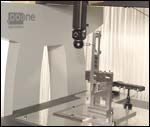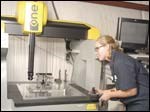Improving Inspection Throughput And Reducing Scrap With CMMs
In the past, this company used primarily conventional machining techniques to manufacture parts and traditional variable gaging such as micrometers, height gages and comparators, as well as attribute gages such as plug gages and function go/no-go gages to inspect dimensional features.
FN Manufacturing LLC (Columbia, South Carolina) manufactures small arms for the military and civilian law enforcement markets. The company employs Mori Seiki horizontal and vertical CNC machining centers as well as conventional machining equipment to produce close-tolerance aluminum and steel components, including receivers, bolts, slides and rails. Subcontract machining, heat treating and surface finishing are also among the company’s specialties.
As part of its large equipment complement, the company operates coordinate measuring machines, including an Xcel 7107, four PFx 454s, four Mistral 775s, two Global 777s and three One 775s, all from Brown & Sharpe (North Kingston, Rhode Island), for its inspection operations.
In the past, FN Manufacturing used primarily conventional machining techniques to manufacture parts and traditional variable gaging such as micrometers, height gages and comparators, as well as attribute gages such as plug gages and function go/no-go gages to inspect dimensional features.
“Our CMM departmental approach has been quality-oriented, with a focus on process control,” says Scott C. Kramer, FN Manufacturing Quality Engineering Supervisor. “We went from using the CMMs for final inspection of parts to in-process verification and acceptance in a short period of time. Our overall number of machines jumped from five to 14 in 6 to 7 years.
“The CMMs have also been an important part of our program to re-industrialize parts to CNC machines,” he continues. “They give us actual numbers in real time to make adjustments to the machining centers.”
All of the company’s CMMs are installed on the shop floor near production equipment. The majority are integrated into the machining center cells, with, on average, one CMM for every four machining centers. Parts are moved to the CMM and manually loaded by the operators. The company says that having a CMM close at hand means that operators spend less time traveling to and from the CMM. In addition, they spend less time waiting for an open machine, in turn reducing overall inspection time. All of the CMMs are tied into FN Manufacturing’s intranet to allow uploading of any inspection program to any machine from a central server.
“Considering that the machining centers are networked the same way, and that jobs are frequently moved from one machining cell to another, CMMs can be managed in this way as well,” says Mr. Kramer. “With this arrangement, we have a good deal of flexibility and confidence that we can provide the required support to our production operations.”
However, this flexibility introduces part programming challenges and the need to examine a different way of grouping programs and handling machine access, says Mr. Kramer.
“We could no longer associate one machine with one or two inspections, and one inspection with one set of probing tips,” he says. “We had to come up with a family or group approach to programs and solve our interchangeability issues.”
Mr. Kramer and his staff solved the problem by creating a generic alignment procedure off of a square L-bracket, instead of using traditional part alignment techniques. Each CMM has a square bolted to the work surface that is used to align each workpiece. The CMMs are set up with a pallet change system that allows any workpiece fixture to be put on any CMM and run with minimal effort by the operator. The machine operator manually nests the workpiece fixture in the square, and the part program is called up and run. No manual alignments are needed when changing over from one workpiece to another or from CMM to CMM.
“Using this procedure, we can measure several different parts throughout the day, and the operator has to perform only one alignment,” says Mr. Kramer. “The individual part programs execute the part alignment, thus saving the operator time while making the CMM more user-friendly.”
The procedure also works with the tip qualifications, the company says. Tip verification is performed once per shift; a full tool rack qualification is performed only when the verification indicates an inconsistency. The one qualification handles all of the in-house probing needs.
“Before a program is released for production, we perform a full correlation back to known methods, such as SMTE, gaging and other methods,” explains Mr. Kramer. “This ensures accurate, reliable programs, which are retained with revision levels. Any change is documented in the program body, and all of the copies are updated in the server and the necessary CMMs. If an update includes new probing, then a correlation is performed for verification. This approach reduces the likelihood of the CMM accepting non-compliant parts as good products by accident.
“Literally, we can go from one machine to another and measure any part as needed,” says Mr. Kramer.
The CMMs located on the shop floor, with the exception of the model One CMMs that have aluminum frame/Plexiglas enclosures (formulated in-house) built around them to protect them from shop contaminates. These enclosures include doors for easy load and unload, the manufacturer says.
Designed specifically for shopfloor measurement and inspection operations, the model One CNC CMM contains critical drive components, all of which are completely enclosed to optimize reliability. Recirculating bearing packs are sealed to resist airborne contaminants, resulting in high life expectancy and low maintenance. The inherent stiffness provides volumetric accuracy and repeatability equal to those of air bearings at a higher level of acceleration, the manufacturer says.
The materials and components used throughout the CMM are designed to minimize thermal effects and enhance measurement throughput and accuracy on the shop floor. Its high-density polymer composite base is said to stiffen the machine to provide ten times more vibration damping than traditional materials. The base also absorbs high-frequency noise typically found on the shop floor, further reducing vibrations that affect measuring accuracy, the manufacturer says.
Dimensional data are used to determine how well the process is running and what adjustments, if any, need to be made to the machining centers. Dimensional data are given to machining center operators in the form of a printed report. The CMMs are also used in reverse engineering applications to feed dimensional data to the company’s engineering department or tool fabrication department in order to improve products and processes.
The volume of dimensional data collected per feature depends upon the critical nature of the feature. “Our goal is to collect as much data as possible while still having a cycle time that does not make the inspection counter-productive,” says Mr. Kramer.
In summary, the CMMs allow for fast inspection of complicated parts. First-piece inspections that used to require days in an open setup are now completed in a few hours, while in-process inspections that sometimes took several hours now take minutes. The company reports that after implementing the CMMs on one particular production line, the capability of the machines was assessed; adjustments were made to the machining centers and the process; and scrap was reduced by 50 percent in less than 4 months.
Read Next
The Automation Event for CNC Machine Shops
Get sensible, real-world automation solutions during this half-day workshop co-located with IMTS 2024.
Read MoreEncountering Surface Finishes in the Everyday World
Surface measurement is becoming increasingly important to ensure proper performance of a manufactured product. Advanced surface measurement tools are not only beneficial in the manufacturing industry but also have unconventional applications.
Read MoreA History of Precision: The Invention and Evolution of Swiss-Style Machining
In the late 1800s, a new technology — Swiss-type machines — emerged to serve Switzerland’s growing watchmaking industry. Today, Swiss-machined parts are ubiquitous, and there’s a good reason for that: No other machining technology can produce tiny, complex components more efficiently or at higher quality.
Read More










 – Medium Rectangle (1).png;maxWidth=300;quality=90)
















